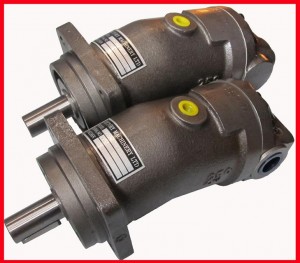
Hydromotors are operators with constant during that are used to make required torque for the rotation of spinning load (eg, turbine) . These operators are classified in the types of costal , feathers and piston .
For selecting a hydromotor at least the followings should be determined:
- Oil displaced volume in ‘cm 3’
- The maximum allowable flow rate through the engine and a maximum speed
- Torque constant in ‘Nm / bar’ by this constant the amount of torque of the motor can be calculated in different working pressures.
- The maximum torque of motor at maximum pressure difference in NM
It is possible to determine the torque and size of hydromotors from the following equation:
T (Nm) = 0.016 × ΔP (bar) × Vg (cm 3 )
In this equation ‘T’ is the torque of hydromotor, Δp is the pressure difference between input and output, and Vg is the volume displacement of hydromotor. This equation is completely similar to the equation ‘F = P × A’ that is used to calculate the cylinder force. Because the movements are linear in cylinders and it is rotational in hydromotors , the force ‘F’ changes to torque ‘T’ and the piston area ‘A’ changes to displacement volume ‘Vg’ .
For example, the torque of a hydraulic motor with 300cm 3 of volumetric displacement and 200bar of Pressure difference can be calculated from the following relation :
T = 0.016 × 200 × 300 = 960 Nm
This means that the hydromotor above is appropriate to rotate a load with 96kg of weight with 1m length of rotation arm . If the load is more than this amount and making more pressure is not possible ,it is necessary to use a hydraulic motor with a larger displacement volume. But we should notice that increasing the replacement volume of motor will increase the required amount of oil for system.
Determining the rotational speed and flow rate of hydromotor is as the following equation:
N (rpm) = 1000 × Q (lit / min) / Vg (cm 3 )
In this equation , ‘N’ is the rotational speed of hydromotor, ‘Q’ is the required flow rate , and Vg is the volume displacement of hydromotor. Determining the power of hydromotor can also be obtained from the following equation:
P (Kw) = T (Nm) × N (rpm) / (9550)
In this equation , ‘p’ is the power of hydromotor , T is the torque and N is the rotational speed of hydromotor . It should be noted that the above equations, are provided without spotting the mechanical and volumetric efficiency . In fact, the amounts of the efficiency effect on torque and power values .
Hydromotors’ main features are as follows:
- Theoretical torque of motor : calculated torque without taking into account mechanical losses
2- Breakaway Torque: the required torque to rotate an immovable load . This torque is more than the necessary torque for continuing the rotation after launch.
3- Running Torque: the necessary torque for the rotation continuing
Running Torque = 0.9 Theoretical Torque
4- Starting Torque: torque the engine needs to make a load rotate.
Starting Torque = 0.7 Theoretical Torque
- Ripple of Torque : is the difference between maximum and minimum torque made by rotation of a motor .
- The overall efficiency of the engine:
1- Gear motors 70-75%
2- Vane motors 75-85%
3-Piston motors 85-95%